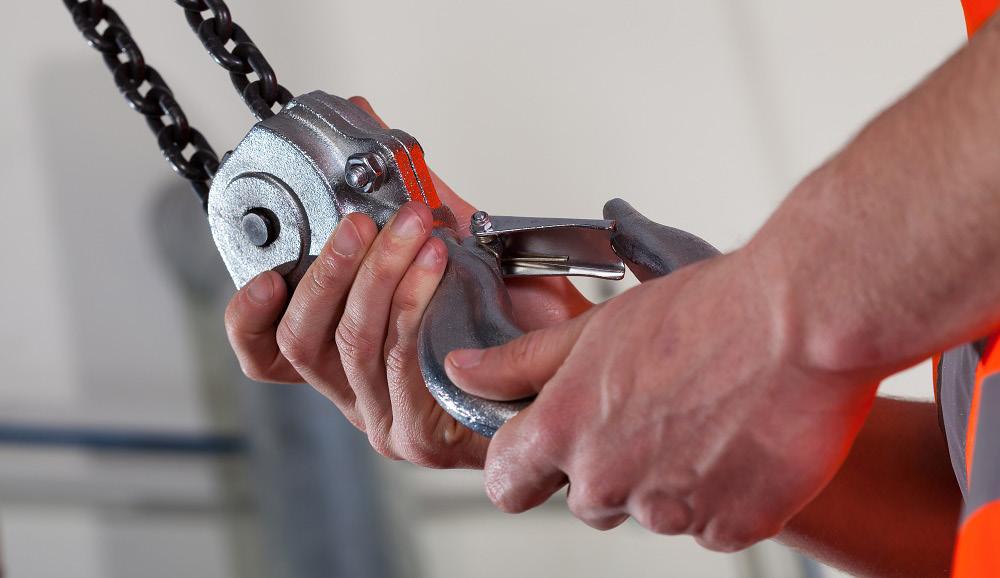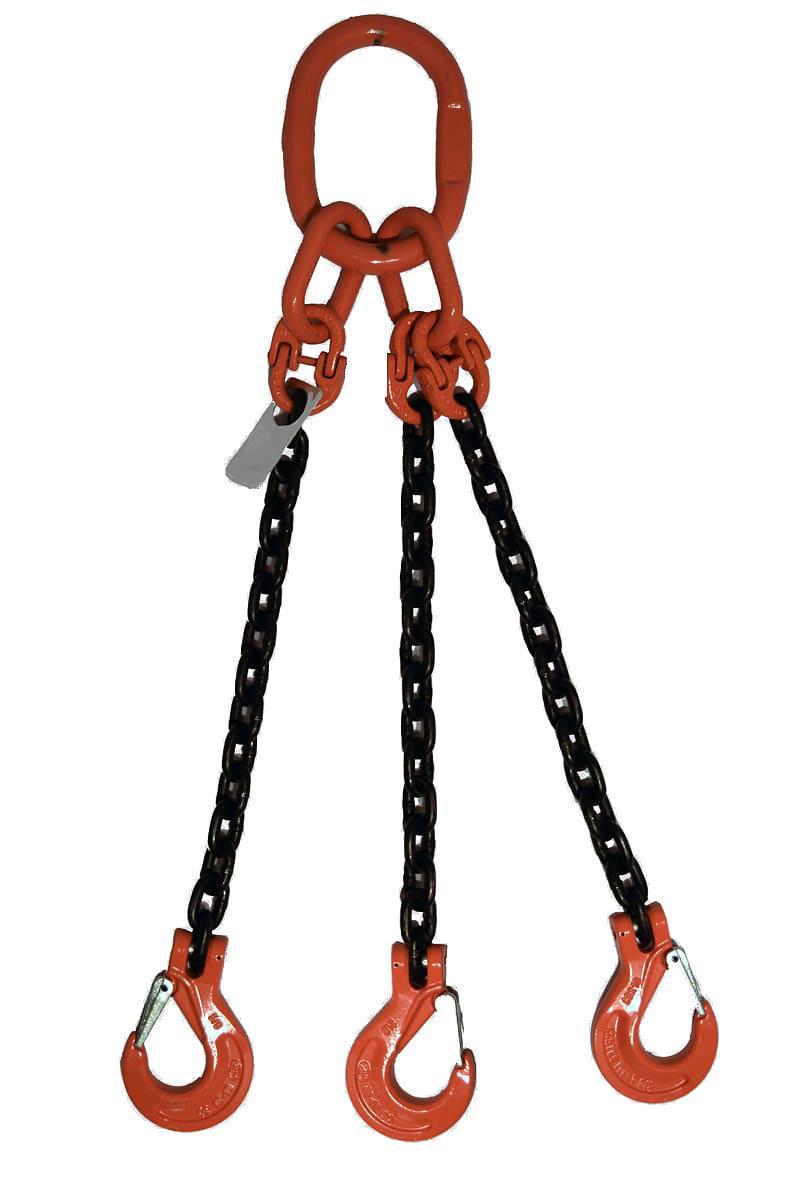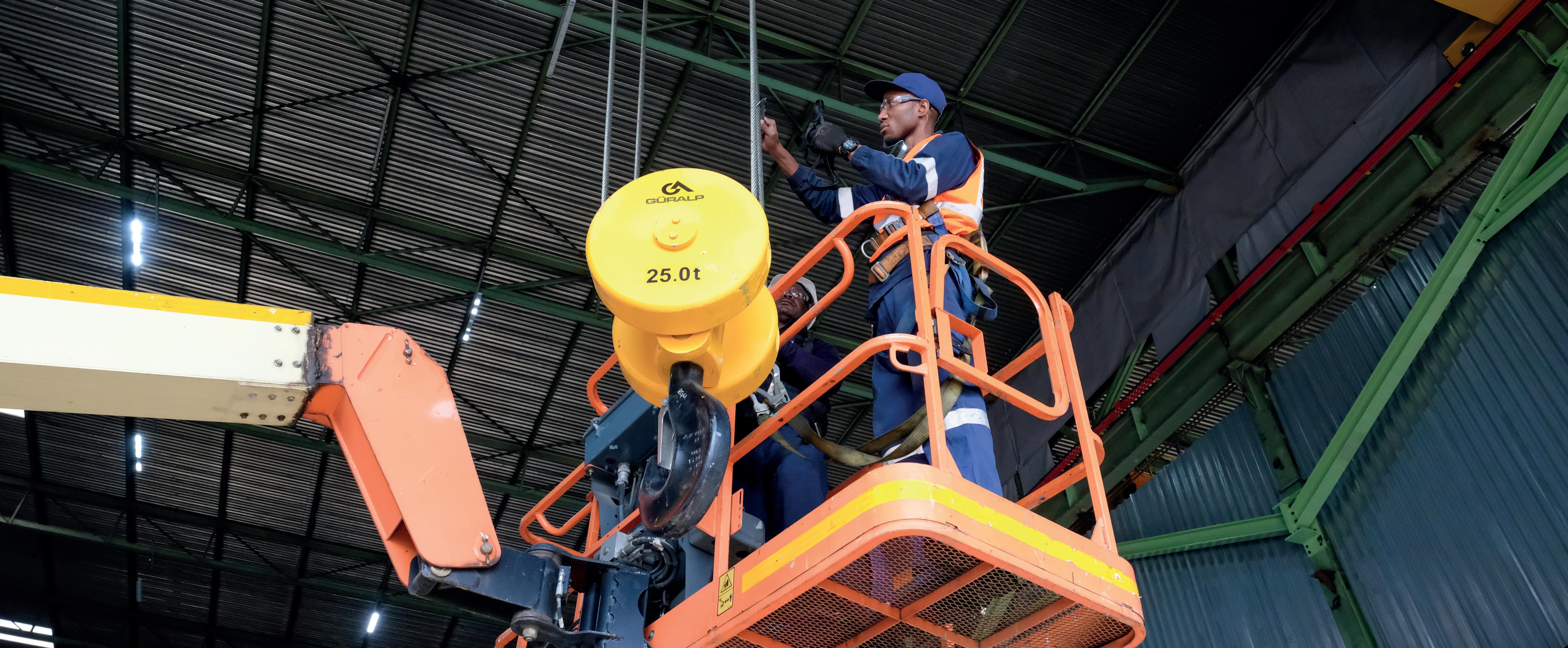
12 minute read
Lifting tackle and hoist testing and inspections
LIFTING TACKLE & HOISTS Lifting tackle and hoist testing and inspections
There often appears to be a lot of confusion in industry and mining, including at major construction sites, regarding the legal requirements for the inspection and/or testing of lifting tackle (LT) and chain blocks and lever hoists, now defined as hand powered lifting devices, in OHSA DMR 18 2015.
Advertisement
It must be noted that the revised DMR 18, published by the DEL, effective October 1, 2015 placed new responsibilities on users and suppliers, with new lifting equipment definitions, user’s responsibilities and revised contents. The revised DMR also incorporates certain lifting equipment SANS documents, which now become mandatory under section 44(1) of the Act. Although LME and LMI requirements for mining operations are not specified in the MHSA Chapter 8 Regulations, these inspection and testing requirements, applicable to lifting machines and hoists, is accepted as compulsory for mines as well. Section 103 of the MHSA is relevant by interpretation. It is common knowledge that all lifting machines, which are classified according to different Codes in the DMR/NCOP, must be performance load tested at intervals not exceeding 12 months, by a service provider or LME, which is a company registered with the DEL.
The actual load test on the lifting machine, including hand powered lifting devices, but excluding lifting tackle, must be conducted or be supervised by a LMI, who is registered with ECSA. The LMI would have been assessed and found competent by a Registration Committee at ECSA, to test only the specific types of machine for which he has been registered for, as a LMI. Note that ECSA do not print the scope of competence of the LMI on his LMI certificate and the only method for the user to establish whether the LMI is competent to load test a specific category of machine, is to request a copy of the LMIs ECSA letter of registration, which reflects his scope. Here are some of the frequently-asked questions around this issue
Visual Inspections compared to Examinations
It is the writer’s interpretation that a visual external inspection

is done by visually checking all visible components of a sling or hoist, in accordance with a properly prepared check list. This inspection can be done by a competent person who is defined in DMR 18 as a “person or inspector, appointed in writing, with the necessary training, knowledge and experience relevant to the type of lifting tackle or hoist that he is inspecting “ An examination is a “detailed study by a competent person in such depth and detail as he considers necessary to enable him /her to determine whether the equipment being examined is safe to remain in use” (SANS 500) This examination could include stripping and repairing of a hoist, and then conducting an operational test on completion. Such an examination can be done by a LMI or appointed competent person such as a technician or artisan.
Must a lifting tackle inspector (LTI) be a registered LMI?
The answer is no.
It must be stressed that a LTI does not have to be a registered LMI. The core function of a LMI is to conduct, or supervise a load test on a lifting machine or hoist. LMIs are qualified to inspect lifting tackle as well, providing they have also had the necessary training and experience. Government notice No: GRN 257, dated March 7, 2008 states “This registration does not apply to persons who examine lifting tackles in terms of regulation 18 (10) (e) of the Driven Machinery Regulations.”
Who can inspect lifting tackle?
Lifting tackle has to be visually inspected, at intervals not exceeding three months, by a “competent person”. The person is deemed competent by virtue of his “knowledge, experience and training” and appointed in writing as a LTI. The LTI should keep a register of these inspections on site. It must be noted that inspections can be conducted at more frequent intervals if so required by the user. No specific inspection periods are specified in the MHSA, Chapter 8.5 Regulations and mines have to specify in their Standard Operating Procedures (SOP) their inspection periods, method, requirements, inspector qualifications etc. There is currently no DEL requirement to register LTI’s with the DEL, although this can be legislated in future. Lifting tackle inspections can be conducted by in house appointed LTI’s or contracted service providers, the latter obviously at a cost to the user. If the user is using a service provider to conduct lifting tackle and hoist inspections, the user should insist on the service provider’s staff providing proof of training and experience, and that they have been appointed, in writing, by the service provider.
Must lifting tackle in use be subjected to annual load testing?
The answer is an emphatic NO Over the last few years this practice has become popular, mostly as a result of the user’s ignorance of legal requirements and service providers who promote this practice for commercial reasons. It must be stated that manufacturers of chain, wire rope and webbing, are totally against this practice as: • It is not a legal requirement in terms of OHSA DMR 18 (10) or any MHSA Chapter 8 Regulations to conduct periodic load testing on slings in use. • It can be detrimental to the service life of a sling or component as a test in excess of the rated WLL can develop a latent defect in the sling that could cause it to fail later on, under repeated loading. • For example, to subject a sling with a WLL of 5 ton, that is 5 years old, to a test load of 10 ton, which is equal to a 100% overload, can be detrimental or damaging to the sling, or to certain components of the sling such as hooks and coupling links etc. • All OEMs specify a WLL for the size and type of sling supplied, and state that the sling must not be subjected to a load in excess of the rated WLL. This WLL is also specified in the relevant Standard, such as a SANS, to which the sling or product is manufactured.. • It is also relevant to take cognizance of OHSA Section 15



“Duty not to interfere with, damage or miss-use things” when load testing slings in use to more that the rated WLL of the sling as this can damage the sling. • To test a 2 ton webbing sling to 4 ton proves nothing as the sling should not fail at a load of less than 14 ton if it conforms to SANS 94, which specifies a FOS of 7:1 Even an inferior, sub- standard 2 ton sling should with stand a proof load of 4 tons but does not confirm that the sling is legal in terms of SANS 94 which requires a minimum 14 ton break load. • All testing of new lifting tackle, must be conducted in accordance with an “accepted or appropriate technical standard” There is no SANS or international standard for load testing slings in use. There are only standards for the OEM to test new slings or components as part of his manufacturing process. For the above reasons, testing of slings in use is therefore not encouraged. Only lifting machines, including hand powered lifting devices, must be periodically load tested by LME/LMIs.
What type of certificates must be supplied with LT and hoists?
The word “Test Certificate” does not appear in the OHSA or MHSA. It is common practice, and the user should insist that suppliers provide either a Certificates of Test or a Certificate of Conformance to a specific quality manufacturing Standard, when purchasing lifting tackle and hoists. A Certificate of Test must state the actual test load, the date of test and other relevant details as specified in the relevant Standard, whereas a Certificate of Conformance must state the Standard, such as a SANS, DIN or EN to which the product has been manufactured. This certificate is regarded as the “birth certificate” of the sling and must be kept on record till the sling is scrapped, after which the certificate can be cancelled as the equipment as it is no longer in use and has been removed from the work place. Slings must be marked with the relevant certificate number, and rated WLL, and other details for traceability back to the supplier. The rule of thumb is “where does it come from and what can it lift?” If a sling is not marked with this information, do not use it! It is also important that users have a written scrapping procedure that specifies the steps to take when scrapping LT, which must include cancelling the suppliers certificate, as the sling is no longer in service.
Slings must be colour coded periodically?
This is not a legal requirement but can be stipulated in a company SOP. There is no international Standard for colour coding either. The practice is to attach a specific colour to a sling or hoist after it has been periodically inspected. It is important to note that a sling is not always safe to use, simply because it is colour coded, and operators should be trained accordingly. Proper colour coding charts must be placed in the work place in conspicuous places etc.
Must sling hooks be fitted with safety latches?
This is also not a legal requirement but, once again can be insisted upon in a company SOP. Certain hooks, such as foundry hooks and grab hooks are not designed to be fitted with latches and these hooks fully comply with international quality standards such as EN 1677. Note that top and bottom hooks fitted to chain blocks and lever hoists must be fitted with latches, as required in SANS 1594 and SANS 1636.
Must sling and hoist hooks be pop marked?
This practice is also not a legal requirement for sling hooks but recommended for crane hooks. Sling hooks can be damaged as a result of incorrect methods of marking and the manufacturer will dispute any subsequent claim for damage etc. See OHSA Section 15 “duty not to interfere with or damage….” Also pop marks should be applied by the supplier before first use. The relevant SANS for chain blocks and lever hoists specify that the OEM “shall supply a means or information for the user to determine if the hook throat opening is in excess of the OEMs specification” This “means or information” can be in the form of marks on the hooks applied by the OEM, or the dimensions can be specified in the operating manual which must be supplied with the hoist. Any hoist that carries a CE mark must be supplied with an EU Declaration of Conformity, a Test Certificate as well as an operating manual and be branded according to CE requirements. The manual will specify hook throat openings.
What marking should be on Shackles?
Shackles do not have to be marked with an individual number. Shackles should be marked with the WLL, the size, a traceable OEM symbol or brand name, as well as with a batch compliance number or mark.
Most shackles are marked in imperial sizes such as 5/8 or 3/4, as most shackles comply with US Federal Specs which are not in metric sizes. Shackles could also be stamped with a specific number of the corresponding supplier’s certificate, but this is not a legal
requirement and must be done in an area recommended by the OEM
WLL versus SWL
These terms are often confused and there is a difference. The WLL is the maximum load to be lifted, lowered or suspended by a hoist or sling as specified by the OEM and specified in the manufacturing Standard The WLL is clearly marked on the hoist or sling tag and is based on the design factor (FOS) and must never be exceeded. All tackle and hoists manufacturing Standards specify that hoists and sling be marked with the WLL, and not the SWL.
The SWL is determined by a competent person depending on the method of use and operational conditions. It can be the same or less, but never more than the WLL.
To name a few examples:
• The SWL of a sling reduces as the angle increases between the sling legs and If chain is used to lift hot loads, the SWL reduces as the chain temperature increases. • If shackles are used at angles the SWL reduces accordingly (at 90° less 50%) • The SWL of a mobile crane is specified on the cranes load chart that specifies the SWL depending on the boom angle and boom extension. Unfortunately, there are many grey areas in both the OHSA and MHSA regarding the use, inspection and testing of lifting equipment and discretion and best practice must be adhered to. Safety Officers and other supervisory personnel must be cautioned not to possibly insist on specific legal requirement if they do not know what the law actually requires. The law is there to be implemented by the user and not to be interpreted for personal or commercial purposes. Lastly properly compiled SOPs (written operating procedures) must specify all lifting equipment requirements, particular to the User’s specific operation and be implemented by their staff and contractors.
To conclude, it must be stressed that the above information is the writer’s opinion only and should not be construed as legal advice or legally binding, but as a guide to promote lifting equipment safety in the work place. Phakamisa Safety Consultants assist to compile customized SOPs, conduct audits and provide specialized lifting equipment training and consulting, with the objective for users to comply with a Total Safe Lifting Program in the work place.
Note that SANS 500 has been updated and will soon be available. As SANS 500 is an incorporated SANS, LMIs must take note of the new testing and reporting requirements.
Phakamisa Safety Consultants,
+27 (0) 82 372 4595, potto@icon.co.za, www.phakamisasafety.co.za


GÜRALP
Providing industry with overhead cranes and hoists, Güralp is synonymous with quality. They combine their experience from the past with today’s customer requirements to offer the latest technological solutions to customers. Guralp considers themselves not just a supplier but a solutions partner. Decades of experience and the use of the latest production technologies underpin PLANETA’S successful formula for lifting gear, suspension units and crane technology. PLANETA lifting gear is designed for the harshest application conditions, and is fully compliant with the latest machinery directive standards. The name PLANETA is synonymous with safety and longevity which really matter. Surelift fulfils the entry level of the RGM Cranes product offering. As the oldest range in the stable it offers value for money and is generally readily available. The lower end of the duty spectrum is the most competitive and RGM Cranes has had fantastic success with this range.
PLANETA SURELIFT










